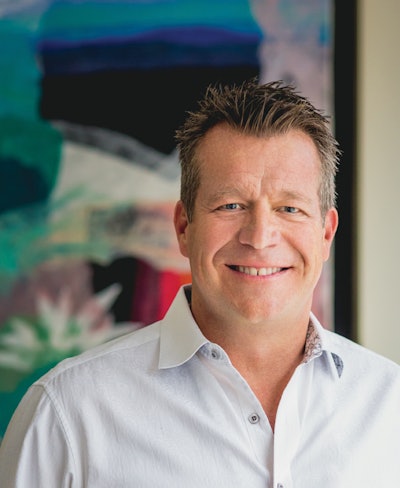
Christian Hageseth has been a lifelong entrepreneur: After graduating from Arizona State, he moved to Seattle and started an ice cream company, then raised money for a mortgage bank and got involved in real estate.
“In real estate, I was making a lot of money, and I was sort of fat, rich and unhappy, to be candid,” he says. “Then in ’08, the best thing that could possibly happen to me happened, and I lost everything. You know, sometimes that’s what it takes to find yourself.”
Trying to rebuild himself, Hageseth bumped into Jake Salazar, co-founder of the MMJ America dispensary, and realized he could build a business around cannabis. He partnered with a private investor (who he calls “Mr. Pink” in his book “Big Weed”) and put $130,000 into renting his first warehouse in Denver and starting a grow. Now the chairman of the board of Green Man Cannabis, Hageseth has partnered on five dispensaries and built six grows in the past seven years.
“I was an entrepreneur lucky enough to lose my ass at the right time, and I found marijuana, or marijuana found me, one way or the other,” he says.
Cannabis Business Times Managing Editor Kyle Brown talked with Hageseth about his inspiration and plan for the Colorado Cannabis Ranch, a winery experience for cannabis set to break ground in November and open in February 2017 through his company, Inspiro, of which he is the founder and president.
Brown: Your background is very solidly business-oriented. As a grower, how did you cover all the things you didn’t know about growing cannabis?
Hageseth: I think that’s what entrepreneurs do. ... There’s always something you have to learn. Also, being an entrepreneur, I’m not a self-performer. I love bringing together the right people to accomplish the goal. To me, that’s really exciting.
In the beginning, growing was certainly one of my weak spots, so I hired a chain of people. I’m on my fifth grower. Corey Buffkin has been my grower for five years. But in the first two years, I ran through four other growers that … didn’t work out for different reasons. So I learned a lot of lessons along the way.
Brown: What are the qualities you want to see in a grower?
Hageseth: The way I look at this business or any business is you have generalists and subject matter experts. For the grow team, they all have to be subject matter experts on growing cannabis.
But for the master grower, a really important part is to be a subject matter expert and to be a generalist. They have to be able to see the whole business. They have to understand the ecosystem that they work within, that their team works within, and they have to be really good communicators.
The scale that the business is getting to, none of this stuff is an individual contributor growing their 12 lights in their room and staying in the business right now. ... We’ve got two teams of growers and then weekly management meetings and monthly board meetings. The master grower has to be able to communicate with all of these groups … and has to be able to function at a board level and communicate at that level, but also communicate to the trim manager.
Brown: What do you see as the qualities you bring to Green Man Cannabis, then?
Hageseth: I think the biggest thing any successful marijuana company has to be right now is flexible and able to adjust to very dynamic circumstances.
Our ability to succeed isn’t that we have the perfect business plan and all the skills in place beforehand, but that we have a culture of being able to shift, to adjust what we’re doing to comply with the rules and do what’s required. It hasn’t always been easy. There have been times where … you have a regulator telling you to do it one way, and you know it’s better another, but it doesn’t matter. If you want to stay in business, you’ve got to follow the rules.
I bring the vision for what the business can be, and then the culture of adaptability and flexibility, because seven years into this industry, we’ve never been cited for anything.
Brown: Tell us about your work on the Colorado Cannabis Ranch.
Hageseth: It was a vision I had about a year after I started the business. Most people have never seen a growing marijuana plant before, much less a large-scale growth facility. [With] my own experience in breweries and wineries, and some of the cool tours and cool experiences I’ve had with those, a light went off.

I call it a “weedery” because I think it’s like a brewery or winery. I have a similar vision that in the not-too-distant future, there are going to be a lot of weederies. ... Just to have that social, cultural center of it and the social involvement of letting people come out and see how marijuana is grown.
The Colorado Cannabis Ranch will be 150,000 [square] feet of greenhouse. People will be able to take a tour through part of it. … The tour will end in a gift shop where they’ll be able to buy all sorts of swag with our brand on it, and there will be an on-site dispensary. They’ll be able to buy the product that’s grown there, as well as other marijuana products, [and there will be a] rooftop restaurant with a bar, and what looks to be a 7,500-person amphitheater at this point. We’re still playing with exactly how many people are going to be in there.
I’m really excited about it from the marijuana side, but also really excited about it from the culture side of creating a place where people can come have an experience with this wonderful plant, but then they can also do other things: watch a band, eat a meal, hang out with friends, just have a happy moment in the sunshine where marijuana is just right there and everything is OK.
I think those experiences for individuals go a long way to changing our collective perception about what marijuana is and where it fits in our society.
Brown: In a previous interview, you said the design will be like a cathedral. What’s the idea behind that?
Hageseth: That’s one aspect of it. Really what I was saying there was that an aspect of the design will be cathedral-like. It will be long and narrow and very tall, much like a cathedral would be. There will be a band of windows at the top. But the setting of it, the aesthetic of it is really just to be nature. There’s light coming in from the top. At the far end, when you walk in, there’s a living green wall of plants with a waterfall coming down on it. So you’ve got this light in this perception of space, which is air and water and plants, and then the floor will be a rough-hewn tile so it will feel like rock or earth. It’s not religious. I just want to put marijuana back in nature.
Brown: What challenges have you faced putting this project together?
Hageseth: Well, I hope you’ve got a lot of time. [Laughs]
Obviously, raising money for the marijuana industry is a unique challenge in its own. In Colorado there are laws about who can own equity in a licensed marijuana entity, and so there’s some legal, structural issues to how we can raise money for it. Also, we’re raising a lot of money for a very big project that’s never been done before and is federally illegal.
And getting kicked out of seven banks hasn’t really helped. At one point, we were raising money for this project, and we didn’t have a bank account. So people considering putting money in asked the very legitimate question of, “How are you going to pay me?” I said, “Well, once a quarter, I can transport cash to you.” They were like, “You’ve got to be kidding me. I don’t want that.”
So those troubles, and there’s a lot, lot more.
Brown: I wanted to specifically ask you about banking. What’s worked for you so far with this project?
Hageseth: We’ve always had this policy on banking to be what my attorney initially described as “open and notorious.” We never hid that the nature of our business was marijuana, and the reason was we never wanted to get caught lying. ... We continue to sign up with banks. Some of them have lasted less than 24 hours and others have lasted a couple of years. We went without banking for about 18 months, and right now we’re banking with a very entrepreneurial credit union that operates here in Colorado.
Brown: Going back to the ranch, why is it important for you to reach this part of the market?
Hageseth: Things are only important because we make them important. And I believe in marijuana. … This plant has a huge amount of potential, both as a safe, recreational intoxicant and as medicine. It’s important for me to retell the story at the ranch because I want to share this benefit with the world, with everyone that we can.
Brown: What’s the most important thing you’ve learned from the cannabis industry?
Hageseth: I think one of the most profound things I’ve learned from marijuana is that it’s part of nature, and it has its own cycle. We could do everything we could to stimulate the growth of the plant, but the plant has its own time. It is going to seed and then grow, and then begin to flower and then finish when it’s ready. Once it starts flowering, I can’t rush it through those 8.5 weeks. You’ve got to be there and do what you can. In real estate, there were days when you’d make a year’s worth of money in a week. And you can grow a year’s worth of marijuana, but it takes a year. Marijuana gave me this fundamental understanding that all of life has this natural rhythm of growth, and we’re just part of it.
Brown: What do cannabis growers need to know about business to be competitive?
Hageseth: If you’re growing today, you have to really understand the market you’re selling into, because it’s changing a lot and quickly.
You have to know the product you’re growing, who’s going to buy it and what price they’re going to pay for it. How do you compare against the others? ... [So], you have to know not just that you’re growing marijuana, but also who you’re growing it for.
















